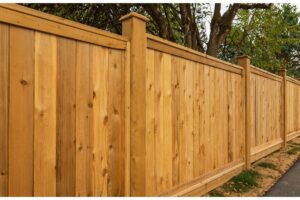A beautiful garden fence can be a blessing and a curse.
Although wooden fencing is beautiful when well kept, it can be the source of steady annoyance and unnecessary stress if you live somewhere like the UK where the temperatures are fluctuating in a spectrum of wet n’ windy.

If you’ve got some old fence panels that are looking rather gloomy, then you’ve come to the right place.
We’ve gathered our top tips from the office and from our timber yard on how you can best maintain and give your old fence a proper uplifting. Come rain or shine, we’ve put together a quick maintenance guide so that your fence can always look its best.
Repair damages as they come
As soon as there’s a chip in your fence, if one of the panels have come loose, or if you’ve got one pillar that’s starting to rot – you’ll have a weakened fence.
Make sure that if a chip comes out or if there’s a split, that it’s glued back on properly under dry conditions and with waterproof glue. That way, your fence will regain its strength quickly.
If you’ve got nails wearing old or rusty, be sure to replace these with strong new ones to reinforce the strength of the fence.

Keep the fence free of leaves and mud
If your fence is in contact with wet objects or in the shade a lot of the time, it can be really hard to keep it looking fresh – even though you are a real maintenance enthusiast and use the best products on the market.
If leaves or other objects land on your fence, be sure to brush them off. If a bush or a tree is starting to lean against the fence, either cut it down or find a way to get it to lean to the other side to give your fence room to breathe and dry up in between wet spells.

Is your fence safe?
Your fence might look strong and durable on the top, but are your pillars rotting up from the inside? If that’s the case then you can do as much maintenance on the visible panels as you want but it won’t make a difference to the structure as it will break down eventually.
Each fence panel is essentially an enormous sail and that puts the entire structure under a massive amount of stress even when there’s just a small breeze. If the wood is weakening or if there’s something else wrong with your fence – then you need to deal with it and replace what’s damaged.
Remember Hurricane Bawbag? Trampolines were flying on the streets because they weren’t properly attached to the ground and had a massive surface that caught every gust of wind. If your fence isn’t secure to the ground, and in pristine condition – that could be your fence flying through the streets when the next storm hits.

Don’t be afraid to try and rock the fence to check if it’s stabile. After all, the rot will usually start from the inside and therefore will practically be invisible the human eye.
Scrub away any dirt, grime and mildew
To really reinvigorate your fence panels, you’ve got to start by making sure that they are clean so that the wood will be receptive to any product or treatment you are going to give it later on.
If there’s any mildew or dirt on the fence, you need to clean it off. For mildew for example, you can either get a mildew remover or give it a good ol’ scrub with soap and warm water.
It’s good practise to scrub your fence panels at least once a year. When you get rid of dirt and grime, the fence will last longer. If you’ve got a pressure washer handy, feel free to use it – just be careful to not have it on a too powerful setting as it can break down certain elements of the wood and damage the fence.

Paint and treatment
Once the wood is clean and has dried off – it’s a good idea to repaint and stain the wood. If you don’t treat the bare wood, it’s more susceptible to things such as rot and insect infestation.
You might not need to treat your fence panels every year, but make sure to to it once every few years when then are looking extra gloomy.
If you don’t want paint or stain on your fence, you should apply a sealer at least once a year. Don’t skimp on the water sealer as that’s the protective layer that will keep moist and mildew away from your wooden fence.

If you want to paint or stain your fence, be sure to put two thin coats on. It’s a good idea to do this on a sunny day (or a dry day at least), so the layers can dry quickly. Wait with the second coat until the first feels dry. You’ll often be able to read on the packaging how long the manufacturer recommends that you wait in between the coats.
A little insider tip, decking oil makes an excellent fence treatment as it’s super durable. A decking treatment such as Cuprinol deck oil and protector keeps the timber water resistant and contains UV filters to protect the panels from the sun.









